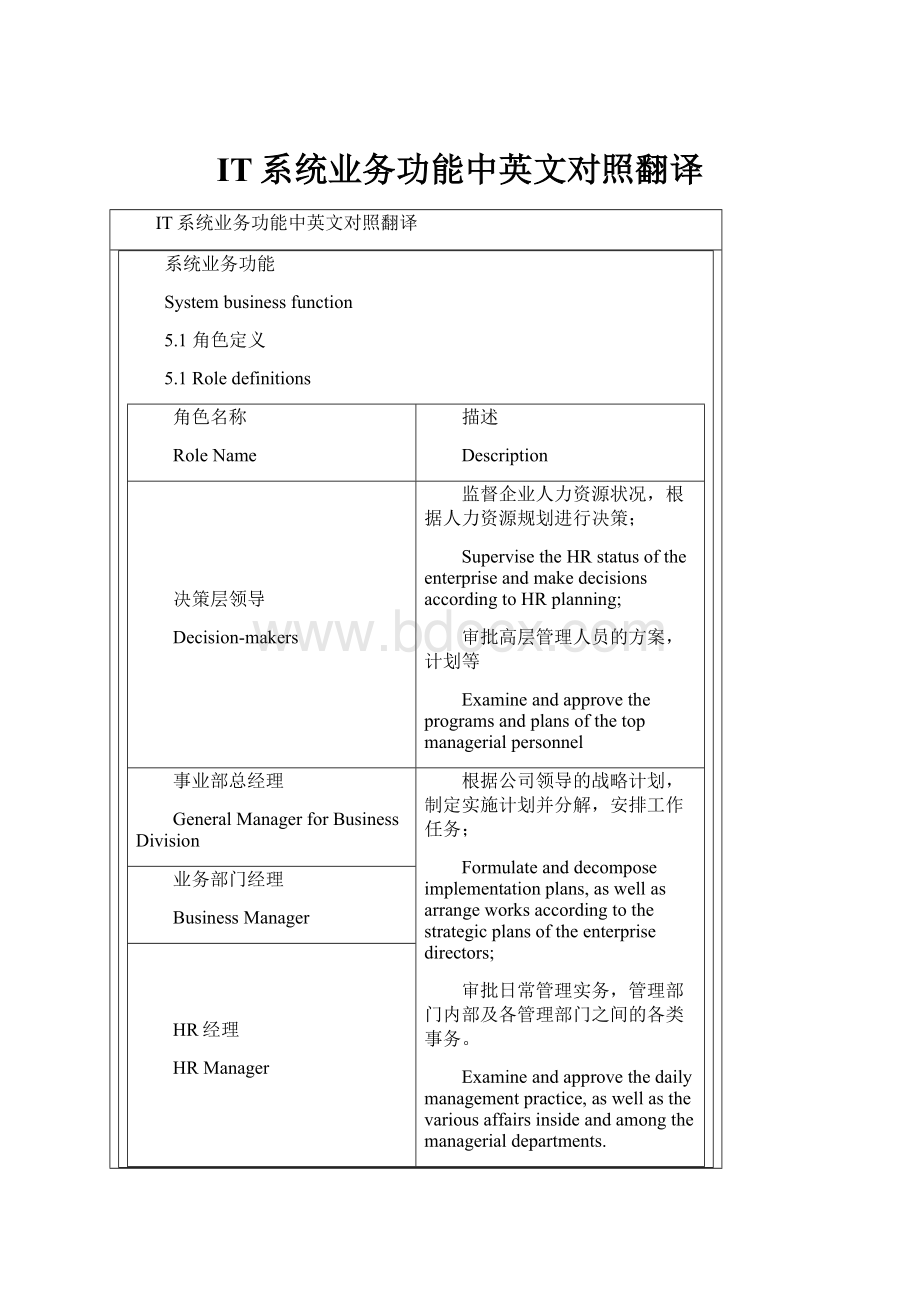IT系统业务功能中英文对照翻译.docx
《IT系统业务功能中英文对照翻译.docx》由会员分享,可在线阅读,更多相关《IT系统业务功能中英文对照翻译.docx(27页珍藏版)》请在冰豆网上搜索。

IT系统业务功能中英文对照翻译
IT系统业务功能中英文对照翻译
系统业务功能
Systembusinessfunction
5.1角色定义
5.1Roledefinitions
角色名称
RoleName
描述
Description
决策层领导
Decision-makers
监督企业人力资源状况,根据人力资源规划进行决策;
SupervisetheHRstatusoftheenterpriseandmakedecisionsaccordingtoHRplanning;
审批高层管理人员的方案,计划等
Examineandapprovetheprogramsandplansofthetopmanagerialpersonnel
事业部总经理
GeneralManagerforBusinessDivision
根据公司领导的战略计划,制定实施计划并分解,安排工作任务;
Formulateanddecomposeimplementationplans,aswellasarrangeworksaccordingtothestrategicplansoftheenterprisedirectors;
审批日常管理实务,管理部门内部及各管理部门之间的各类事务。
Examineandapprovethedailymanagementpractice,aswellasthevariousaffairsinsideandamongthemanagerialdepartments.
业务部门经理
BusinessManager
HR经理
HRManager
HR专员
HRCommissioner
(分类:
行政,招聘,培训。
考勤)
(Classification:
administration,recruitment,trainingandattendancechecking)
执行HR经理分配的任务,如招聘,培训安排,考勤等日常事务的处理;
PerformthetasksassignedbyHRManager,suchasrecruitment,trainingarrangement,attendancecheckingandotherroutineaffairs;
与公司各部门员工进行沟通协调,协同办公
Communicate,coordinateandcollaborateofficewithemployeesofotherdepartments
相关负责人
RelatedPrincipals
管理项目组,车间,产品线等单元中的人员及事务
PersonnelandaffairsinManagementprojectteam,workshopsandprojectlines.
普通职员
GeneralStaffs
查看维护个人信息;
Viewandmaintainpersonalinformation;
获取个人的工资,考勤,合同,休假,培训,绩效等信息;
Gainpersonalinformationaboutwages,workattendance,contract,holiday,trainingandperformance,etc.
进行休假申请,查看审批结果;
Requestforvacationandcheckapprovalresults;
进行考核自评,培训申请,空缺职位申请,推荐等。
Makeself-assessment,trainingapplication,vacancyapplicationandrecommendation,etc.
系统管理员
SystemAdministrator
维护系统正常运作,权限管理,基础数据管理等
Maintainthenormaloperationofthesystem,accesscontrolandbasicdatamanagement,etc.
5.2整体功能设计
Overallfunctiondesign
IntegrationApplication
Seves
Group
ERP
DXI
Data
ExchangeInterface
Portal
EmployeeSelf-
servicePortal
InformationBrowsing
Statistical
Forms
DecisionSupport
PaymentManagement
BudgetManagement
DailyRoutine
TimeManagement
TrainingManagement
PerformanceManagement
ContractManagement
FileManagement
RecruitmentManagement
OrganizationalManagement
PersonnelInformation
PositionInformation
DecisionLayer
Business
Layer
BasisLayer
基础层包含的是变动很小的静态数据,主要有两大类,一类是员工个人属性数据,如姓名、性别、学历等;另一类是企业数据,如企业组织结构、职位设置、工资级别、管理制度等。
基础数据在HR系统初始化的时候要用到,是整个系统正常运转的基础。
Basislayercontainsstaticdataofsmallchanges,includingtwomaincategories:
oneisthedataconcerningemployees’personalattributes,suchasname,gender,educationalbackground;theotherisenterprisedata,suchasenterpriseorganizationalstructure,positionsetting,wagegradeandmanagementsystem,etc.ThebasicdataarerequiredinHRsysteminitializationandregardedasthebasisforthenormalrunningofthewholesystem.
业务层对应于人力资源管理具体业务流程的系统功能,这些功能将在日常管理工作中不断产生与积累新数据,如新员工数据、薪资数据、绩效考核数据、培训数据考勤休假数据等。
这些数据将成为企业掌握人力资源状况、提高人力资源管理水平以及提供决策支持的主要数据来源。
BusinesslayercorrespondstothesystemfunctionsofthespecificworkflowofHRmanagement.Thesefunctionsconstantlyproduceandaccumulatenewdatainthedailymanagementworks,suchasdatafornewstaffs,payroll,performanceappraisal,training,workattendanceandholiday,etc.ThesedatawillbecomethemainsourcesfortheenterprisetomastertheHRstatus,improveHRmanagementandprovidedecisionsupport.
决策层建立在基础数据与大量业务数据组成的HR数据库基础之上,通过对数据的统计和分析,能快速获得所需信息,如工资状况、员工考核情况等。
这不仅能提高人力资源的管理效率,而且便于企业高层从总体把握人力资源情况。
DecisionlayerisfoundedontheHRdatabasethatisformedbybasicdataandmassbusinessdata.Bystatisticalanalysis,thelayercanacquireusefulinformationquickly,suchasstatusofwageandstaffappraisal,etc.ItcannotonlypromotetheHRmanagementefficiency,butalsohelptheseniorleveloftheenterprisegrasptheHRstatusasawhole.
员工自助服务门户是员工了解企业的门户,是员工与HR管理部门沟通的窗口,HR可以充分了解员工对企业的意见与反馈,可以让员工充分参与企业的发展,了解公司的组织架构、文化、规章制度等。
Employeeself-serviceportalistheportalfortheemployeestounderstandtheenterpriseandthewindowforthecommunicationbetweenemployeesandHRmanagementdepartment.HRcanfullyunderstandtheopinionsandfeedbacksofemployeesontheenterprise,letemployeesbetterparticipateintheenterprisedevelopmentandknowabouttheorganizationalstructure,culture,rulesandregulationsoftheenterprise.
数据交换接口提供与其他系统的丰富的接口,既能数据导入,又能数据输出;既提供一般数据接口,如EXCEL格式的数据转换,又提供了基于Web服务的系统接口,如与SAPECC6.0、OracleEBS系统的专用接口。
能够方便将现有的系统中数据实现平滑过渡,避免资源浪费,同时加快开发进程。
DataExchangeInterface(DEI)providesvariousinterfacesconnectingothersystems,whichcaninputandoutputdata;providegeneraldatainterface,suchasdataexchangeinEXCELformat,aswellassysteminterfacebasedonWebservice,suchasthespecialinterfaceofSAPECC6.0andOracleEBS.DEIcaneasilyrealizethesmoothtransitionofthecurrentdatainthesystem,avoidresourcewasteandacceleratethedevelopmentprocess.
5.3功能模块设计
5.3FunctionalModuleDesign
5.3.1组织管理
5.3.1OrganizationalManagement
组织机构管理用于建立企业的人力资源管理的组织结构、职位体系、岗位体系。
并建立企业的职务职能体系和职业技能标准,为工作分析、员工能力素质评价建立数据基础。
从而,建立现代人力资源管理的基础。
Theorganizationalmanagementisusedtobuildtheorganizationalstructure,positionsystemandpostsystemofenterpriseHRmanagement,createthepositionfunctionalsystemandvocationalskillstandards,providedatabasisforjobanalysisandemployeecapability&competenceevaluation,andthusestablishthefoundationofmodernHRmanagement.
建立企业内各级人力资源组织,包括法人组织与职能机构(职能部门),并建立各级组织间关系。
形成人力资源组织关系,作为各人力资源业务系统内部的汇报关系。
EstablishtheenterpriseHRorganizationsatalllevels,includingcorporateorganizationandfunctionalorganizations(functionaldepartments),buildrelationsbetweenorganizationsatalllevelsandformHRorganizationalrelationshipasthereportingrelationshipinsidevariousHRbusinesssystems.
依据企业工作分析的结果,建立企业内部职务体系,职位体系,岗位体系,并依据职位评价的结果,通过职位建立企业的职位薪资体系。
并可以通过岗位之间的上下级关系建立企业各项HR业务的审批流程。
员工任职方式有多种,可以有正式任职,兼职,临时代理等。
Basedontheresultofenterpriseworkanalysis,buildtheinternalpostsystem,positionsystemandjobsystemfortheenterprise;inaddition,accordingtotheresultofpostevaluation,establishthepostsalarysystemfortheenterprise.Throughtherelationsbetweenhigherandlowerposts,createtheexaminationandapprovalprocessforthevariousHRbusinessoftheenterprise.Staffscanholdapostinagreatmanyways,suchasformally,part-timeandtemporarily,etc.
职能要素管理,职能要素表明一项最基本的工作任务。
同时,同一个任务,对不同岗位的人员要求也是不同的,因此对同一职能要素进行分级管理。
职能要素是建立职位,岗位说明书的基础。
Functionalelementmanagement:
Functionalelementindicatesthemostbasicworkassignment.Meanwhile,asthesameassignmenthasdifferentrequirementsonstaffsofdifferentposts,itisnecessarytoimplementdecentralizedmanagementtothesamefunctionalelement.Functionalelementisthefoundationtocreatepositionandpostspecifications.
资格要素管理,资格要素是企业对员工所拥有的知识,能力,技能要求。
企业内规范的资格要素体系即是企业的职业技能标准。
对同一项自个要素进行分级管理。
资格要素是建立职位,岗位说明书的基础。
Qualificationelementmanagement:
Qualificationelementsaretheknowledge,abilityandskillrequirementsoftheenterpriseonemployees.Theregulatoryqualificationelementsystemintheenterpriseisthevocationalskillstandardoftheenterprise.Implementdecentralizedmanagementtothesamequalificationelement.Qualificationelementisthefoundationtocreatepositionandpostspecifications.
5.3.2 人事管理
5.3.2PersonnelManagement
处理并跟踪员工从入职直至离职全过程的信息。
建立包括员工个人工作档案,员工个人能力素质模型的建立,评估,更新。
员工所服务组织,担任的职位,岗位历次变更,员工培训的所有历史记录,员工薪资变更记录,员工职位发展过程,员工绩效成绩档案,劳动合同及变更,奖惩记录等全方位员工视图。
Processandtrackthestaffinformationfromtheirappointmenttodemission.Establishpersonalworkingfiles,build,evaluateandupdatethepersonalcapabilityandcompetencemodelforstaffs.Createanall-roundstaffviewoftheorganizationandpositionservedbystaffs,eachpostchange,allhistoricalrecordsofstafftraining,recordsofemployeesalarychanges,developmentprocessofstaffpositions,employeeperformancearchives,laborcontractsandchanges,rewardsandpunishmentrecords,etc.
员工档案信息是整个HR系统的基础,大部分的报表都来自对员工档案信息的统计和分析。
员工档案信息内容完整,采用结构化的方法进行管理,主要包括员工档案,个人简历,变更记录,素质模型四大部分。
StafffileinformationisthebasisfortheentireHRsystemandmostreportscomefromthestatisticsandanalysisofstafffiles.Thestafffileinformationiscompleteincontent,managedwithastructuredapproachandincludingfourmajorparts,suchasstafffiles,CVs,changerecordsandcompetencemodel.
员工素质模型,根据对员工在企业中任职能力的评估评价结果建立员工个人能力素质模型。
根据企业的职工技能标准进行持续的评估和跟踪,可维护其历史记录。
员工能力素质模型可用于员工对岗位,职位适应性匹配,以及用于员工聘任,选拔,调配,培训,职业生涯管理等的管理决策。
Staffcompetencemodel:
establishthepersonalcapacityandcompetencemodelonthebasisoftheevaluationandassessmentofstaffs’workingabilityintheenterprise.Makeongoingassessmentandtrackingaccordingtotheemployeeskillstandardsoftheenterprisetomaintainthehistoricalrecords.Staffcapacityandcompetencemodelcanbeusedintheapplicabilitymatchofpostsandpositions,aswellasthemanagementdecisionofemployrecruitment,selection,deployment,trainingandcareermanagement,etc.
员工入职管理,用于处理员工入职时的个人资料检查,员工档案登记,素质模型初次建立,初次工作任命及其他如合同签订,入职培训等相关操作。
以及管理员工试用期,转正等。
Staffappointmentmanagementisusedtocheckpersonalinformation,registerstafffiles,establishcompetencemodel,assignworks,signcontractandcarryoutappointmenttrainingandotherrelevantoperationswhentheemployeejoinstheenterprise,aswellasmanagestaffs’probationandobtainmentofpermanentstatus.
岗位编制管理,企业可根据需要决定是否启用岗位编制管理。
使用岗位编制可以进行人力资源数量规划,发现岗位空缺,追踪招聘结果。
岗位编制有多种不同的管理方式,系统指定定员,确定上限,确定下限,确定编制范围等。
Poststaffingmanagement:
theenterprisecandeterminewhethertoenablethepoststaffingmanagemen